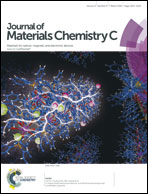Optimized photoluminescence of red phosphor K2TiF6:Mn4+ synthesized at room temperature and its formation mechanism†
Abstract
A red phosphor K2TiF6:Mn4+ (KTFM) has been synthesized by etching Ti(OC4H9)4 in HF solution with KMnO4 and KF at room temperature for 30 min. The formation mechanism of red phosphor KTFM has been discussed based on detailed experimental results. We studied the influences of synthetic procedure and KMnO4 concentration on the powder color and intensity of phosphor luminescence. The actual doping concentration of Mn4+ in the K2TiF6 (KTF) host lattice of the phosphor has been investigated by measuring the concentration of filtrate through ICP-AES analysis. The results showed that about 32.4 mol% of Mn elements was doped into KTF crystals at optimal Mn4+ concentration (in precursor solution). The presence of HF was found to be essential to doping Mn4+ into KTF due to the weakly acidic and complexing properties of HF. The red luminescence of Mn4+ in KTF with a crystal structure matching standard card JCPDs (#28-0825), was first observed in the sample prepared from HF solution concentrations lower than 5 wt%. The dependence of the intensity of the luminescence on HF concentration might be due to the varying of Mn4+ concentrations in KTF crystals. Higher HF concentration was associated with lower yield, because KTF is soluble in HF at high concentrations. Encapsulation of the red phosphor KTFM with YAG:Ce on a GaN layer produces “warm” white LEDs with color rendering of 86 at 3251 K.


 Please wait while we load your content...
Please wait while we load your content...